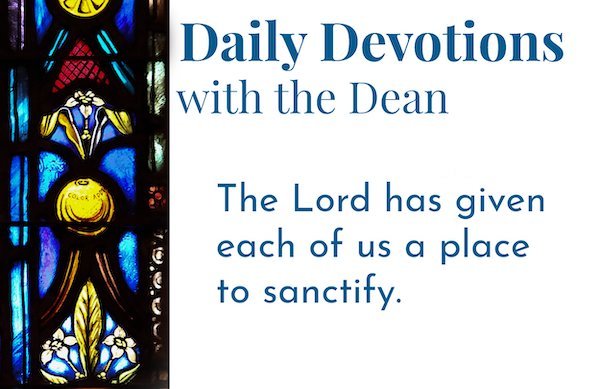Friday • 1/12/2024 •
Today we close out a two-week detour from the Daily Office. Instead, we’ll be thinking through various facets of worship and how our Lord provides meaningful communion with him through our formal corporate worship as well as in individual worship in our daily devotions. The thoughts offered here are excerpts from articles I wrote for Worship Leader magazine a few years ago.
“With Four-Part Harmony and Feeling”
Maybe you’re like me? On any given Sunday, I may show up for worship worn out or close to giving up or guilty and ashamed – or ready to celebrate. I know there’s an even more diverse range of moods among the people I’m called to lead. How can the worship of Jesus’ people rise from such disparate hearts? How can worship leaders orchestrate such discordant voices?
“With four-part harmony and feeling.” That’s how Arlo Guthrie introduces the last chorus of his classic story-song “Alice’s Restaurant.” To me, it’s an apt summary of God’s gift to us of the four voices through which he tells us Jesus’ story: Matthew, Mark, Luke, and John. In his “four part, one song” gift, God provides hope that Jesus can make sweet music of our disparate voices.
It’s not a given that we would have access to Jesus through precisely these four gospels. Some people in the early days of the church experimented with something else. Marcion (mid-2nd century, Rome) championed an edited Luke over the other three — and wound up pitting a New Testament God of love against the Old Testament God of wrath. Epic fail. Tatian (mid-2nd century, Assyria) tried to amalgamate the four gospel accounts into a single narrative — the result was a mish-mash. Less epic, but fail nonetheless.
Nor have other sources been that helpful. Historians like the Roman Tacitus (2nd century) and the Jewish Josephus (a turncoat during the 1st century war with Rome) do little more than note that Jesus lived. The Gospel of Thomas (2nd century, Egypt) gives us sayings (many quite odd), but little of the story. The Gospel of Judas (2nd century, Egypt) gives us story, but one that just didn’t ring true.
For the last 200 years or so, scholarship has tried to get behind “the Christ of the Gospels” in quest of “the Historical Jesus.” The problem is that scholarship is done by scholars, and scholars are people. Consistently, those scholars’ quests lead them to a Jesus that looks just like them. Churches have their own reductionistic bent. Protestants filter Jesus through the apostle Paul. Catholics favor the Synoptics (Matthew, Mark, and Luke) because of the Synoptics’ ethical teachings. The Orthodox favor John because of his perceived otherworldliness.
But the reality is that the four Gospels pressed themselves in concert upon the early church; and the early church wisely let each sing its own part of the song.
The four-winged creatures of the book of Revelation gave the early church its most powerful metaphor for the singular message and fourfold voice of the Gospels: “the first living creature like a lion, the second … like an ox, the third … with the face of a man, and the fourth … like an eagle in flight” (Rev 4:7). Each has eyes for sight, and wings for flight. Each ceaselessly worships: “Holy, holy, holy, is the Lord God Almighty” (4:8).
Each winged creature became associated in the early church’s mind with a particular gospel. Each became a metaphor for its gospel’s angle of vision, its aspect of Christ’s message to be taken to the nations, and its facet of worship.
Matthew is the winged man because Matthew begins with Christ’s genealogy. Beyond that, Matthew presents Jesus as “gentle and lowly in heart,” and as one especially attuned to the burdens of “all who labor and are heavy laden” and who need “rest for your souls” (11:28,29). Matthew’s Jesus is Emmanuel (“God with us,” 1:23) who teaches in the Sermon on the Mount what our true humanity looks like.
Mark is the winged lion because Mark begins with John the Baptist roaring like a lion in the desert. Beyond that, in his focus on Christ’s coming “not to be served but to serve, and to give his life as a ransom for many,” Mark shows Christ’s true, Aslan-like power.
Luke is the winged ox because Luke begins with Zachariah fulfilling priestly duties in the Temple. As Irenaeus (2nd century, Gaul) notes, “For now was made ready the fatted calf about to be immolated for the finding again of the younger son.” Luke, Paul’s traveling companion, is the only Gentile author in the NT. His two volume Luke/Acts is rooted in “secular” history and the ethical sensibilities of the Gentile world. He understands especially well that humanity experiences redemption through Jesus fulfilling OT sacrificial requirements and promises.
John is the winged eagle because the eagle is a good symbol for Christ’s coming from above as the divine Logos. With his seven “I am” statements (6:35; 8:12; 10:7; 10:11; 11:25; 14:6; 15:1) and Jesus’ crowning claim, “Before Abraham was I am” (8:58), John offers the most exalted view of Christ in the NT. Doubting Thomas speaks for all of us when he confesses: “My Lord and my God.”
As Jesus reveals himself through his fourfold gospel, he speaks to the diverse needs of his people. Some hear him say, “You will find rest for your souls.” Some hear the Father rejoicing because the fatted calf has been sacrificed and they are welcomed home. Some hear that Christ is their Lion-protector. And we all find ourselves bowing before the one who is the great “I am.”
Be blessed this day,
Reggie Kidd+

















